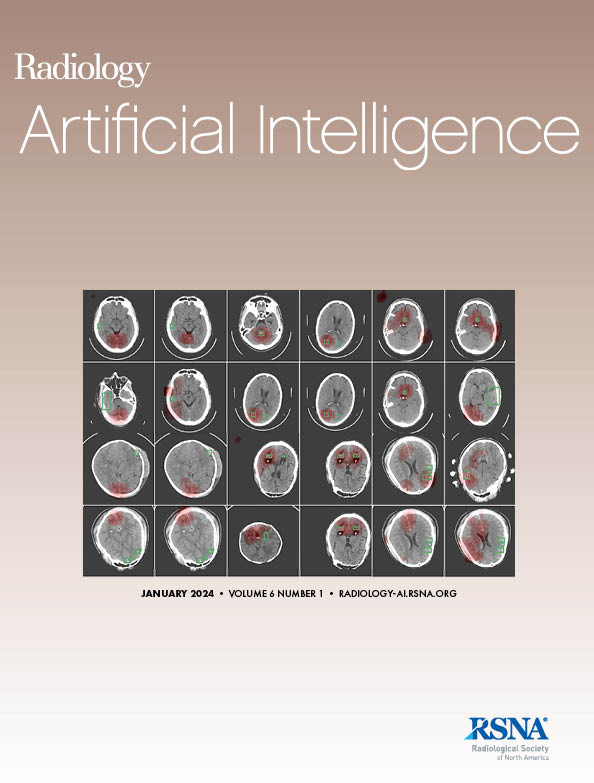下载PDF
{"title":"Collaborative Integration of AI and Human Expertise to Improve Detection of Chest Radiograph Abnormalities.","authors":"Akash Awasthi, Ngan Le, Zhigang Deng, Carol C Wu, Hien Van Nguyen","doi":"10.1148/ryai.240277","DOIUrl":null,"url":null,"abstract":"<p><p>Purpose To develop a collaborative artificial intelligence (AI) system that integrates eye gaze data and radiology reports to improve diagnostic accuracy in chest radiograph interpretation by identifying and correcting perceptual errors. Materials and Methods This retrospective study used public datasets REFLACX (Reports and Eye-Tracking Data for Localization of Abnormalities in Chest X-rays) and EGD-CXR (Eye Gaze Data for Chest X-rays) to develop a collaborative AI solution, named Collaborative Radiology Expert (CoRaX). It uses a large multimodal model to analyze image embeddings, eye gaze data, and radiology reports, aiming to rectify perceptual errors in chest radiology. The proposed system was evaluated using two simulated error datasets featuring random and uncertain alterations of five abnormalities. Evaluation focused on the system's referral-making process, the quality of referrals, and its performance within collaborative diagnostic settings. Results In the random masking-based error dataset, 28.0% (93 of 332) of abnormalities were altered. The system successfully corrected 21.3% (71 of 332) of these errors, with 6.6% (22 of 332) remaining unresolved. The accuracy of the system in identifying the correct regions of interest for missed abnormalities was 63.0% (95% CI: 59.0, 68.0), and 85.7% (240 of 280) of interactions with radiologists were deemed satisfactory, meaning that the system provided diagnostic aid to radiologists. In the uncertainty-masking-based error dataset, 43.9% (146 of 332) of abnormalities were altered. The system corrected 34.6% (115 of 332) of these errors, with 9.3% (31 of 332) unresolved. The accuracy of predicted regions of missed abnormalities for this dataset was 58.0% (95% CI: 55.0, 62.0), and 78.4% (233 of 297) of interactions were satisfactory. Conclusion The CoRaX system can collaborate efficiently with radiologists and address perceptual errors across various abnormalities in chest radiographs. <b>Keywords:</b> Perception, Convolutional Neural Network (CNN), Deep Learning Algorithms, Radiology-Pathology Integration, Unsupervised Learning, CoRaX, Perceptual Error, Referral, Deferral <i>Supplemental material is available for this article.</i> © RSNA, 2025 See also commentary by Levi and Laghi in this issue.</p>","PeriodicalId":29787,"journal":{"name":"Radiology-Artificial Intelligence","volume":" ","pages":"e240277"},"PeriodicalIF":13.2000,"publicationDate":"2025-09-01","publicationTypes":"Journal Article","fieldsOfStudy":null,"isOpenAccess":false,"openAccessPdf":"https://www.ncbi.nlm.nih.gov/pmc/articles/PMC12464715/pdf/","citationCount":"0","resultStr":null,"platform":"Semanticscholar","paperid":null,"PeriodicalName":"Radiology-Artificial Intelligence","FirstCategoryId":"1085","ListUrlMain":"https://doi.org/10.1148/ryai.240277","RegionNum":0,"RegionCategory":null,"ArticlePicture":[],"TitleCN":null,"AbstractTextCN":null,"PMCID":null,"EPubDate":"","PubModel":"","JCR":"Q1","JCRName":"COMPUTER SCIENCE, ARTIFICIAL INTELLIGENCE","Score":null,"Total":0}
引用次数: 0
引用
批量引用
Abstract
Purpose To develop a collaborative artificial intelligence (AI) system that integrates eye gaze data and radiology reports to improve diagnostic accuracy in chest radiograph interpretation by identifying and correcting perceptual errors. Materials and Methods This retrospective study used public datasets REFLACX (Reports and Eye-Tracking Data for Localization of Abnormalities in Chest X-rays) and EGD-CXR (Eye Gaze Data for Chest X-rays) to develop a collaborative AI solution, named Collaborative Radiology Expert (CoRaX). It uses a large multimodal model to analyze image embeddings, eye gaze data, and radiology reports, aiming to rectify perceptual errors in chest radiology. The proposed system was evaluated using two simulated error datasets featuring random and uncertain alterations of five abnormalities. Evaluation focused on the system's referral-making process, the quality of referrals, and its performance within collaborative diagnostic settings. Results In the random masking-based error dataset, 28.0% (93 of 332) of abnormalities were altered. The system successfully corrected 21.3% (71 of 332) of these errors, with 6.6% (22 of 332) remaining unresolved. The accuracy of the system in identifying the correct regions of interest for missed abnormalities was 63.0% (95% CI: 59.0, 68.0), and 85.7% (240 of 280) of interactions with radiologists were deemed satisfactory, meaning that the system provided diagnostic aid to radiologists. In the uncertainty-masking-based error dataset, 43.9% (146 of 332) of abnormalities were altered. The system corrected 34.6% (115 of 332) of these errors, with 9.3% (31 of 332) unresolved. The accuracy of predicted regions of missed abnormalities for this dataset was 58.0% (95% CI: 55.0, 62.0), and 78.4% (233 of 297) of interactions were satisfactory. Conclusion The CoRaX system can collaborate efficiently with radiologists and address perceptual errors across various abnormalities in chest radiographs. Keywords: Perception, Convolutional Neural Network (CNN), Deep Learning Algorithms, Radiology-Pathology Integration, Unsupervised Learning, CoRaX, Perceptual Error, Referral, Deferral Supplemental material is available for this article. © RSNA, 2025 See also commentary by Levi and Laghi in this issue.
人工智能与人类专业知识的协同集成以提高胸片异常的检测。
“刚刚接受”的论文经过了全面的同行评审,并已被接受发表在《放射学:人工智能》杂志上。这篇文章将经过编辑,布局和校样审查,然后在其最终版本出版。请注意,在最终编辑文章的制作过程中,可能会发现可能影响内容的错误。目的开发一种集成眼睛注视数据和放射学报告的协作AI系统,通过识别和纠正感知错误来提高胸片解释的诊断准确性。材料和方法本回顾性研究利用公共数据集REFLACX和EGD-CXR开发了一个名为协作放射学专家(CoRaX)的协作人工智能解决方案。它采用大型多模态模型来分析图像嵌入、人眼注视数据和放射学报告,旨在纠正胸部放射学的感知错误。所提出的系统使用两个模拟误差数据集进行评估,这些数据集具有五种异常的随机和不确定变化。评估的重点是系统的转诊过程、转诊质量及其在协作诊断设置中的表现。结果在基于随机屏蔽的错误数据集中,28.0%(93/332)的异常被改变。系统成功地纠正了21.3%(71/332)的错误,还有6.6%(22/332)的错误仍然没有解决。该系统识别漏诊异常感兴趣的正确区域的准确率为63.0% [95% CI: 59.0%, 68.0%],与放射科医生互动的85.7%(240/280)被认为是满意的,这意味着该系统为放射科医生提供了诊断帮助。在基于不确定性屏蔽的误差数据集中,43.9%(146/332)的异常被改变。系统纠正了34.6%(115/332)的错误,其中9.3%(31/332)未解决。该数据集预测缺失异常区域的准确度为58.0% [95% CI: 55.0%, 62.0%], 78.4%(233/297)的相互作用是令人满意的。结论CoRaX系统可以有效地与放射科医生协作,解决胸片中各种异常的感知错误。©RSNA, 2025年。
本文章由计算机程序翻译,如有差异,请以英文原文为准。

 求助内容:
求助内容: 应助结果提醒方式:
应助结果提醒方式:


